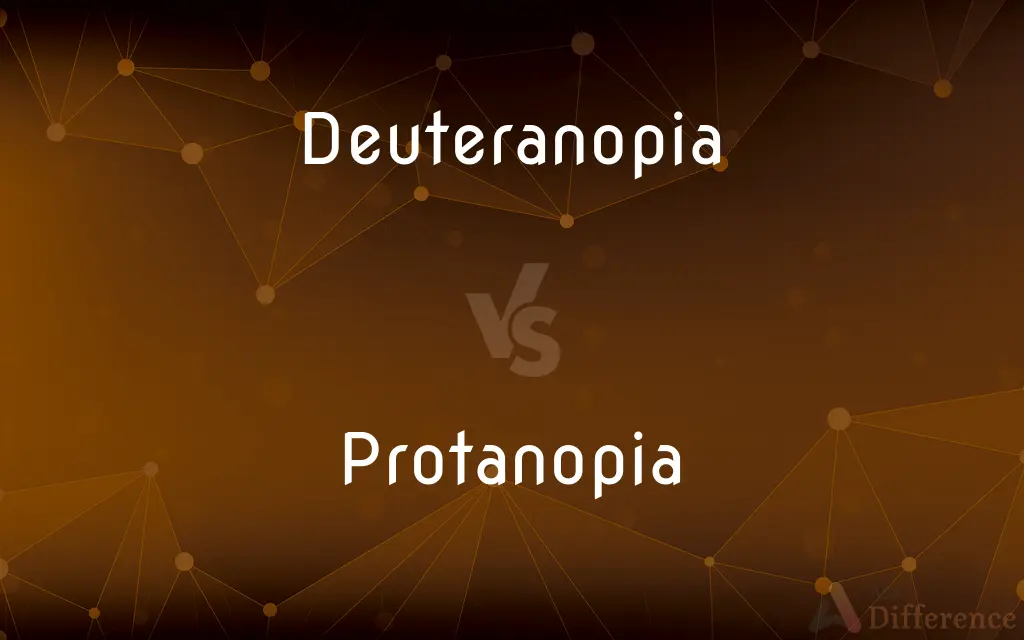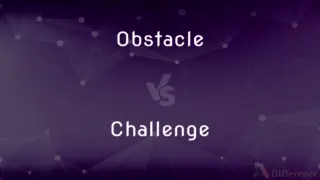Deuteranopia vs. Protanopia — What's the Difference?
By Urooj Arif & Fiza Rafique — Updated on April 26, 2024
Deuteranopia and Protanopia are types of red-green color blindness, whereas Deuteranopia affects green photoreceptors while Protanopia impairs red ones.

Difference Between Deuteranopia and Protanopia
Table of Contents
ADVERTISEMENT
Key Differences
Deuteranopia affects the green photoreceptors (cone cells) in the eye, leading to difficulty distinguishing between colors in the green spectrum. Whereas, Protanopia involves a deficiency in the red photoreceptors, making it challenging for individuals to perceive red shades accurately. Both conditions are forms of red-green color blindness, yet they differ fundamentally in the type of cone defect.
Individuals with Deuteranopia often confuse shades of green with reds and browns, which can make everyday tasks like selecting ripe fruit or interpreting traffic lights difficult. On the other hand, those with Protanopia may find it particularly challenging to distinguish between reds and greens, and they might also struggle with colors that contain red, such as purple.
Due to the malfunctioning green cones in Deuteranopia, the world appears with more red and brown tones, altering the way various colors are perceived. Conversely, Protanopia leads to an environment where greens are more prevalent, affecting how red and related colors are viewed.
Both Deuteranopia and Protanopia can affect visual acuity and contrast sensitivity, but the impact on color perception is their most noticeable manifestation. While people with Deuteranopia might see traffic lights as beige, those with Protanopia might perceive them as being light blue or gray.
Despite the challenges, many individuals with Deuteranopia or Protanopia adapt to their visual limitations using tools like color-coded apps or modified displays, which help them distinguish colors more effectively. Protanopia, however, might require different types of aids tailored to address the specific red deficiencies.
ADVERTISEMENT
Comparison Chart
Affected Cone
Green (medium wavelength)
Red (long wavelength)
Common Confusions
Greens with reds and browns
Reds with greens and blues
Perception of Traffic Lights
Often appear beige or light brown
May appear light blue or gray
Impact on Daily Life
Difficulty distinguishing between similar brightness colors
Challenges in recognizing red-based colors
Adaptation Tools
Color filters and contrast-enhancing lenses
Specialized apps and modified screen settings
Compare with Definitions
Deuteranopia
A form of color blindness involving the inability to perceive green light.
People with Deuteranopia often mistake green for red.
Protanopia
A type of color vision deficiency where red cones are absent or faulty.
Protanopia causes difficulty in distinguishing red signals.
Deuteranopia
Does not affect general visual acuity, only color perception.
Despite his Deuteranopia, he enjoys watching movies without any issue.
Protanopia
It is another form of red-green color blindness.
Protanopia affects his ability to enjoy the autumn colors.
Deuteranopia
It is caused by the absence or malfunction of green cone cells.
Due to Deuteranopia, he sees traffic lights as almost the same color.
Protanopia
Leads to challenges in distinguishing red from green and blue.
In a garden, Protanopia can make red flowers look black.
Deuteranopia
Affects about 1% of males and is very rare in females.
His Deuteranopia is why he prefers grayscale images.
Protanopia
More common in males, affecting approximately 1%.
His Protanopia complicates choosing clothing that matches.
Deuteranopia
This condition is a type of red-green color blindness.
Deuteranopia makes it hard to tell if a banana is ripe by its color.
Protanopia
Color perception is altered, but clarity and sharpness remain.
He has Protanopia, yet he notices textural details very well.
Deuteranopia
A form of colorblindness characterized by insensitivity to green.
Protanopia
A form of colorblindness characterized by defective perception of red and confusion of red with green or bluish green.
Deuteranopia
A form of color blindness in which the retina is deficient in or lacks cone cells containing opsins that respond to the color green, resulting in an inability to distinguish red from green.
Protanopia
(pathology) A form of color blindness. Involves a defect in distinguishing between red and green.
Deuteranopia
Dichromacy characterized by a lowered sensitivity to green light resulting in an inability to distinguish green and purplish-red
Protanopia
Dichromacy characterized by lowered sensitivity to long wavelengths of light resulting in an inability to distinguish red and purplish blue
Common Curiosities
What is Deuteranopia?
Deuteranopia is a form of color blindness where green cones in the eye do not function properly, leading to difficulties in distinguishing green hues.
Are Deuteranopia and Protanopia common?
Both conditions are relatively rare, each affecting about 1% of the male population and even fewer females.
How does Protanopia affect vision?
Protanopia causes individuals to have trouble seeing red colors, often confusing them with green or blue shades.
How are Deuteranopia and Protanopia diagnosed?
These conditions are typically diagnosed through color vision tests administered by eye care professionals.
Can Deuteranopia and Protanopia be treated?
There is no cure for either condition, but various tools and aids can help manage the color perception challenges.
What daily challenges do people with Deuteranopia face?
People with Deuteranopia may struggle with tasks that require color discrimination, such as cooking or choosing clothing.
What are the main differences in color perception between Deuteranopia and Protanopia?
Deuteranopia mainly affects perception of green and red shades, while Protanopia impacts the perception of red and sometimes blue tones.
Is there genetic predisposition to Deuteranopia or Protanopia?
Yes, both conditions are often inherited in an X-linked manner, primarily affecting males.
What tools assist people with Deuteranopia in daily life?
Tools like color identification apps and contrast-enhancing glasses can help manage Deuteranopia.
Do Deuteranopia and Protanopia affect night vision?
No, these conditions typically do not impact the ability to see in low light; they only affect color perception.
What can be confusing for someone with Protanopia during everyday activities?
Everyday activities like selecting ripe fruits or interpreting colored signals can be problematic for someone with Protanopia.
Are there specific careers that people with Deuteranopia or Protanopia should avoid?
Careers that require accurate color vision, such as electrical work, painting, or piloting, may be more challenging for those with these conditions.
Can children be tested for Deuteranopia and Protanopia?
Yes, children can be tested for these conditions, often as part of routine eye examinations.
How do people with Protanopia perceive traffic lights?
People with Protanopia may see traffic lights as light blue or gray instead of red.
How do people with Protanopia manage their condition?
Individuals with Protanopia often use specialized software and visual aids to differentiate colors more clearly.
Share Your Discovery

Previous Comparison
Distillation vs. Filtration
Next Comparison
Obstacle vs. ChallengeAuthor Spotlight
Written by
Urooj ArifUrooj is a skilled content writer at Ask Difference, known for her exceptional ability to simplify complex topics into engaging and informative content. With a passion for research and a flair for clear, concise writing, she consistently delivers articles that resonate with our diverse audience.
Co-written by
Fiza RafiqueFiza Rafique is a skilled content writer at AskDifference.com, where she meticulously refines and enhances written pieces. Drawing from her vast editorial expertise, Fiza ensures clarity, accuracy, and precision in every article. Passionate about language, she continually seeks to elevate the quality of content for readers worldwide.












































